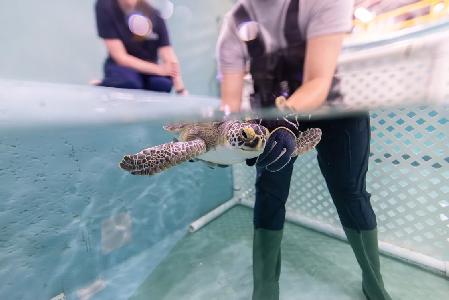METALCON has a damn good name. It also had some damn good demos at the Baltimore Convention Center this week.
The event was a major gathering for construction pros looking for new ideas. The exhibit hall had lots of tools, and demos about the latest ways to build. To kick off the conference, however, Roderick Jackson challenged attendees to think bigger.
“We literally build buildings the same way we’ve built them for centuries,” said Jackson, who heads up the Building Envelope Systems Research Group at the Department of Energy’s Oak Ridge National Laboratory in Tennessee.
Instead of the latest tools, Jackson brought a whole house to the convention. Called the Additive Manufacturing Integrated Energy (AMIE), it’s a prototype of a home that shares energy between the house itself and a hybrid car.

Roderick Jackson inside AMIE. (Photo by Stephen Babcock)
Being a DOE project, one problem it’s solving is the fact that buildings use lots of energy. AMIE points toward energy usage that doesn’t have to rely completely on a grid. Power from solar panels and the electric vehicle batteries flows back and forth through a wireless system developed at national lab. The vehicle has a natural gas generator that produces power for the home.
There’s also lots of new approaches in the construction. The building was entirely 3D printed (on the world’s largest 3D printer). That makes a zero-waste construction process. It’s made of polymer, but Jackson said it’s designed to get folks thinking about what materials available to them can be used. Inside, the wall cavity was reduced from 8 inches to 1 inch to make room for next-generation insulation. The one-room design is simple, complete with Murphy bed. But that’s also a canvas to create.

AMIE’s windows. (Photo by Stephen Babcock)
The speed of the project also marked a big change, process-wise. Jackson said the project was completed in nine months. That’s fast for government, but the level of change points to government’s strengths in taking on the risk.
“The role of government is to take on the risk the private sector wouldn’t take on,” he said. “Now industry can take what we did and move it forward.”

(Photo by Stephen Babcock)
Corporates were already involved in the prototype phase. Jackson’s team got partners like Alcoa, Clayton Homes, GE Appliances, Tru-Design and NanoPore. They were excited about doing something that wasn’t only new, but also big.
“The biggest thing that I learned from this is people don’t get excited about incremental,” he said. Rather, partners and others really gathered around an idea “when you start throwing stuff out there that’s moonshot-type ideas.”
Join the conversation!
Find news, events, jobs and people who share your interests on Technical.ly's open community Slack

Baltimore daily roundup: An HBCU innovation champion's journey; Sen. Sanders visits Morgan State; Humane Ai review debate

Baltimore daily roundup: Medtech made in Baltimore; Sen. Sanders visits Morgan State; Humane Ai review debate

Baltimore daily roundup: The city's new esports lab; a conference in Wilmington; GBC reports $4B of economic activity


